
Vukovar-Srijem County, Vukovar-Sirmium County or Vukovar-Syrmia County, named after the eponymous town of Vukovar and the region of Syrmia, is the easternmost Croatian county. It includes the eastern parts of the region of Slavonia and the western parts of the region of Syrmia, as well as the lower Sava river basin, Posavina and Danube river basin Podunavlje. Due to the overlapping definitions of geographic regions, division on Slavonia and Syrmia approximately divides the county vertically into north-west and south-east half, while division on Posavina and Podunavlje divides it horizontally on north-east and south-west half.
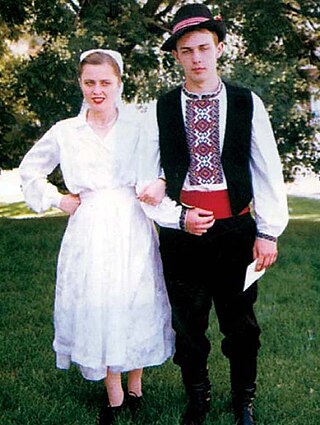
Pannonian Rusyns, also known as Pannonian Rusnaks, and formerly known as Yugoslav Rusyns, are ethnic Rusyns from the southern regions of the Pannonian Plain. Their communities are located mainly in Vojvodina, Serbia, and Slavonia, Croatia. In both of those countries, they are officially recognized as a national minority, and have several minority institutions and organizations.
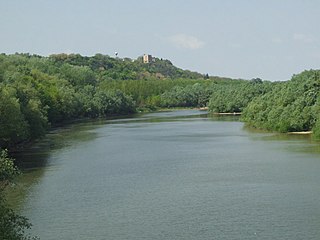
Erdut is a village and a municipality in eastern Croatia some 37 km east of the major city of Osijek. Lying on the border with neighbouring Serbia, it was the site of the signing of the 1995 Erdut Agreement, which initiated the UNTAES transitional administration over the Eastern Slavonia, Baranja and Western Syrmia.
Voćin is a village and municipality in western Slavonia, Croatia, located southwest of Slatina and east of Daruvar. The population of the municipality is 1,911, with 956 people living in Voćin itself.

Markušica is a village and a municipality in Vukovar-Syrmia County in eastern Croatia. Markušica is located south of the river Vuka and northwest of the town of Vinkovci. The landscape of the Markušica Municipality is marked by the Pannonian Basin plains and agricultural fields of wheat, maize, common sunflower and sugar beet.

Negoslavci is a village and a municipality in Vukovar-Syrmia County in eastern Croatia. It is located south of the town of Vukovar, seat of the county. Landscape of the Negoslavci Municipality is marked by the Pannonian Basin plains and agricultural fields of maize, wheat, common sunflower and sugar beet.

Šodolovci is a village and a municipality in Osijek-Baranja County in eastern Croatia. In the seven villages of the Šodolovci Municipality, there were 1,653 inhabitants at the time of the 2011 Census.
Civljane is a village and municipality in Šibenik-Knin County, Croatia. With only 239 inhabitants, it is the smallest municipality in Croatia by population. Civljane is an underdeveloped municipality which is statistically classified as the First Category Area of Special State Concern by the Government of Croatia.
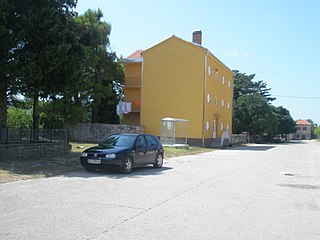
Ervenik is a village and municipality in Šibenik-Knin County, Croatia. There were 826 inhabitants (municipality) in 2021, and 97.19% of the population were Serbs, making Ervenik the municipality with the highest percentage of Serbs in Croatia. Population of the village was 243.

Kistanje is a village and municipality in the Šibenik-Knin County, Croatia. It is located in Bukovica, a region of the Dalmatian Hinterland,
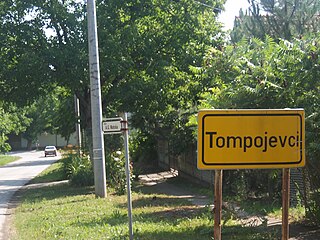
Tompojevci is a village and municipality in the Vukovar-Syrmia County in Croatia.
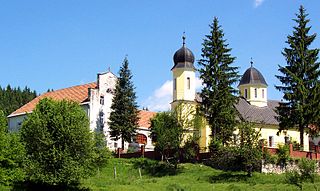
Eastern Orthodoxy in Croatia refers to adherents, religious communities, institutions and organizations of Eastern Orthodox Christianity in Croatia. It is the second-largest religious denomination in Croatia, behind the Roman Catholic Church. Over 128 000 people, forming 3.32% of the total Croatian population, are Eastern Orthodox Christians (2021).

Pačetin is a village in the municipality of Trpinja, Vukovar-Syrmia County in the easternmost part of Croatia. At the time of the 2011 Census the population of the village was 541. Village lies north of the Vuka River and west of the M601 railway. Its major landmark is the Church of St. Nicholas from the 18th century. County road Ž4111 passing through the villages of Pačetin, Bobota and Vera connect all three villages with D2 road and D55 road. Pačetin is 28.6 km southeast of Osijek, the economic and cultural centre of Slavonia and 17.2 km from the Osijek Airport. County seat Vukovar is 17.3 km east of Pačetin.
Donji Žirovac is a village in Croatia. It is connected by the D6 highway. The village has 53 residents according to 2001 census, most of whom are of the Serbian ethnicity.
Divuša is a village in Croatia. It is connected by the D47 highway.

Čakovci is a village in the Tompojevci municipality in eastern Croatia.

Petrovci is a village in eastern Croatia, in the municipality of Bogdanovci. According to the 2011 census, it had a population of 864. The majority of residents are ethnic Rusyns.
Rujevac is a village in central Croatia, in the municipality of Dvor, Sisak-Moslavina County. It is connected by the D6 highway.

Church of St. Nicholas in Mikluševci is Serbian Orthodox church in eastern Croatia. The church was constructed in period between 1758 and 1766 at the site of an earlier wooden Orthodox church which in 1756 served 31 Orthodox household in the village. This wooden church was dedicated to St. Nicholas as well. From the 19th century onward the village was settled by Greek Catholic Pannonian Rusyns settlers from Carpathian Ruthenia which changed religious structure of the settlement. In 1880 out of 712 inhabitants 467 were Greek Catholic, 227 Eastern Orthodox, 11 Roman Catholic and 7 Jewish. Parrish Hall of the Church of St. Nicholas was destroyed two times in history, once during the World War II and in 1991 again during the Croatian War of Independence. Iconostasis, which is the main property of the Church of St. Nicholas, is since Croatian War of Independence kept and under restoration of Matica srpska in Novi Sad. Today the village of Mikluševci are not an independent Serbian Orthodox parish but are part of the Sotin parish.

The Church of the Nativity of the Theotokos in Mikluševci in eastern Croatia is a Greek Catholic parish church of the Greek Catholic Church of Croatia and Serbia. It was constructed in 1907. The local Pannonian Rusyns Greek Catholic community was established in 1859 and canonically recognized in 1930. The church was damaged during the Croatian War of Independence. The Greek Catholic Rusyn community started to settle in Mikluševci in the early 19th century and already in 1880 out of 712 inhabitants 467 were Greek Catholic, 227 Eastern Orthodox, 11 Roman Catholic and 7 Jewish

























